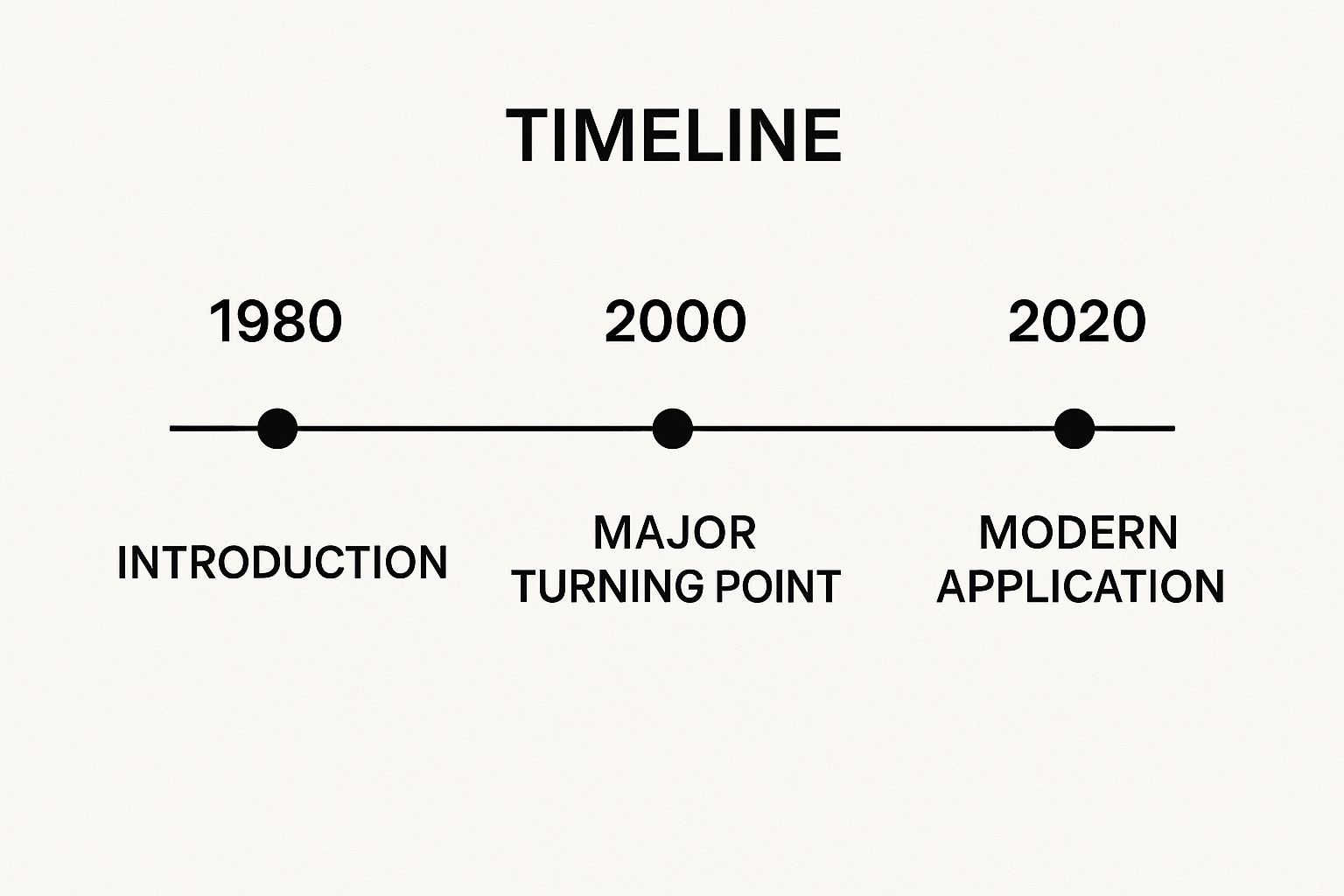Unlocking the Power of Evergreen Content
Want to create content that continues to attract traffic and leads long after publishing? This listicle provides eight evergreen content examples to boost your 2025 content strategy. Learn how to create high-value pieces that build brand authority and offer a lasting return on investment. Discover powerful formats like how-to guides, original research, and resource lists, all designed to capture audience attention and elevate your brand’s presence. These evergreen content examples will give you the tools to build a sustainable and effective content strategy.
1. How-To Guides and Tutorials
How-to guides and tutorials are a cornerstone of evergreen content examples. They provide step-by-step instructions designed to teach readers how to accomplish specific tasks or solve particular problems. From tying a shoelace to mastering advanced coding techniques, these instructional pieces remain relevant for years because the core processes they explain often change little over time. This enduring relevance makes them one of the most reliable forms of evergreen content for attracting and engaging your target audience.

A well-crafted how-to guide follows a clear problem-solution format, outlining a specific problem and then systematically guiding the reader through the steps needed to resolve it. This approach is highly effective because it directly addresses user search intent – people are actively looking for solutions, and a well-optimized tutorial can provide exactly what they need. Features of successful how-to content include numbered steps, visual aids (screenshots, videos, diagrams), and a clearly defined outcome. For instance, imagine a reader searching for "how to bake a chocolate cake." A successful how-to guide will not only provide the recipe but also include step-by-step images of the mixing process, baking times, and frosting techniques, ensuring a successful outcome for the reader.
How-to guides offer numerous benefits: they consistently drive traffic over time due to their evergreen nature, build authority in niche areas by showcasing expertise, and are easy to update with minor revisions as needed. Think of Moz's 'Beginner's Guide to SEO' – it remains a go-to resource for anyone starting in SEO, consistently driving traffic to their site and establishing Moz as an industry leader. While creating evergreen content is crucial, ensuring accessibility to a broad audience is equally important. For businesses, this can include incorporating diverse payment options. A great resource for understanding this aspect is How to Accept Bitcoin Payments: Easy Guide for Businesses from Flash: how to accept Bitcoin payments. Similarly, HubSpot’s “How to Create a Facebook Business Page” and Kitchn’s “How to Cook Perfect Rice” remain relevant and highly searched evergreen content examples.
While the core instructions of a how-to often remain consistent, periodic updates might be necessary as technologies or methods evolve. For example, a tutorial on using a specific software might need updating when a new version is released. The competitive landscape for popular tutorial topics can also be a challenge. However, focusing on timeless processes rather than trending tools and including troubleshooting sections for common issues can help your how-to guide stand out and maintain its evergreen status.
Pros:
- High search intent alignment
- Consistently drives traffic over time
- Builds authority in niche areas
- Easy to update with minor revisions
Cons:
- May require periodic updates as technologies or methods evolve
- Can become outdated if not maintained
- Competitive landscape in popular tutorial topics
Tips for Creating Evergreen How-To Guides:
- Focus on timeless processes rather than trending tools.
- Use clear, numbered steps.
- Include troubleshooting sections for common issues.
- Update occasionally to keep examples current while maintaining core instructions.
By following these guidelines, you can create compelling, evergreen how-to guides that will serve as valuable resources for your target audience for years to come, contributing significantly to your long-term content strategy.
2. Comprehensive Resource Lists
Comprehensive resource lists are a powerful form of evergreen content because they act as a one-stop shop for valuable information on a specific topic. They compile a curated collection of tools, websites, books, articles, or other resources relevant to a particular niche or purpose. This consolidated approach saves readers time and effort they would otherwise spend scouring the internet for individual resources. When well-researched, organized, and regularly updated, these lists become indispensable reference points, drawing readers back repeatedly and establishing the creator as a valuable resource within their field. This repeat traffic is a hallmark of successful evergreen content examples.

A well-crafted resource list typically features categorized resources, often grouped by function or purpose. Brief descriptions accompanying each link provide context and help users quickly identify relevant materials. Many successful resource lists include both free and premium options, catering to a wider audience. This type of evergreen content works exceptionally well because it fulfills a core user need: access to reliable, organized information. For example, a digital marketer searching for SEO tools can save hours by consulting a comprehensive list rather than researching each tool individually.
Examples of Successful Implementations:
- Backlinko's "List of 200+ Google Ranking Factors": This exhaustive list provides a detailed breakdown of factors influencing Google search rankings, making it a go-to resource for SEO professionals.
- Creative Bloq's "The best free fonts": This regularly updated list caters to designers seeking high-quality free fonts, saving them time and effort in their search.
- Smashing Magazine's "Learning Resources For Front-End Developers": This curated list provides aspiring and experienced developers with valuable learning materials, contributing to their professional development.
- The Balance's "The 8 Best Investing Books of 2023": This example demonstrates how resource lists can be tailored to specific timeframes, offering current recommendations for readers.
Pros:
- High shareability and link-earning potential: Valuable resource lists are frequently shared and linked to by others, increasing visibility and driving organic traffic.
- Positions creator as an authority: By curating a high-quality resource list, you demonstrate expertise and establish yourself as a trusted source of information within your niche.
- Opportunity for affiliate marketing: Including affiliate links to premium resources can generate revenue while providing value to your audience.
- Can attract backlinks from listed resources: Websites featured in your list may link back to you, further boosting your SEO.
Cons:
- Requires regular maintenance: Links can break, resources become outdated, and new options emerge. Consistent maintenance is crucial for preserving the list's value.
- Can quickly become outdated without updates: Regularly reviewing and updating the list is essential for ensuring its accuracy and relevance, especially in rapidly evolving fields.
- Labor-intensive to create comprehensively: Thorough research and compilation of resources requires a significant time investment.
Tips for Creating Effective Resource Lists:
- Create a system for periodic reviews and updates: Schedule regular reviews to ensure the list remains current and accurate.
- Include date of last update to build trust: Displaying the last update date demonstrates your commitment to maintaining a fresh and reliable resource.
- Focus on quality over quantity: A smaller list of truly valuable resources is more effective than a lengthy list filled with mediocre options.
- Add unique insights about each resource rather than just listing them: Providing your own perspective on each resource adds value and differentiates your list from others.
Why this deserves its place in the list of evergreen content examples: Resource lists address a fundamental need for easily accessible, organized information. Their inherent value and potential for long-term relevance make them a cornerstone of any successful evergreen content strategy. Whether you are a social media manager, digital marketer, content creator, small business owner, or marketing agency, a well-crafted resource list can become a valuable asset, driving traffic, building authority, and establishing your presence within your chosen field.
3. Definitional Content and Encyclopedic Articles
Definitional content and encyclopedic articles are cornerstones of evergreen content. These pieces comprehensively explain core concepts, terms, or ideas, effectively answering fundamental "what is" questions. They provide authoritative, in-depth explanations that remain relevant for extended periods, requiring minimal updates because they cover foundational knowledge. This type of content serves as a reliable source of information, attracting a consistent audience seeking to understand key concepts within a specific field. This makes them a valuable asset for any content strategy aiming for long-term visibility and impact, making them a worthy inclusion in this list of evergreen content examples.
How it Works:
Definitional content breaks down complex subjects into digestible parts, providing historical context, background information, and clear explanations. They often utilize visual aids like diagrams, charts, and infographics to enhance understanding. By citing authoritative sources and offering comprehensive coverage, these articles become go-to resources for individuals seeking a thorough understanding of a particular topic.
Examples of Successful Implementation:
- Investopedia: Provides clear and concise definitions of financial terms, making it a leading resource for investors and financial professionals. (www.investopedia.com)
- Khan Academy: Offers in-depth explanations of various scientific concepts, using engaging videos and interactive exercises to facilitate learning. (www.khanacademy.org)
- Moz's "What is SEO?" guide: Serves as a comprehensive introduction to Search Engine Optimization, explaining core concepts and strategies. (moz.com)
- WebMD's condition explanations: Offer detailed descriptions of various medical conditions, symptoms, and treatments, making it a trusted resource for health information. (www.webmd.com)
Actionable Tips for Creating Definitional Content:
- Break complex topics into digestible sections: Use headings, subheadings, and bullet points to organize information logically.
- Use analogies and examples to clarify difficult concepts: Relate abstract ideas to real-world scenarios to enhance understanding.
- Include visual aids like diagrams or infographics: Visual representations can simplify complex information and improve engagement.
- Link to related concepts to create a knowledge web: Interlinking related articles allows readers to delve deeper into specific areas of interest.
When and Why to Use This Approach:
Definitional content is ideal when you want to:
- Establish topical authority: Demonstrate your expertise in a specific niche by providing comprehensive explanations of key concepts.
- Attract a beginner-level audience: Draw in individuals new to a subject and nurture them into long-term followers.
- Create low-maintenance content: Once created, definitional articles require minimal updates, freeing up resources for other content initiatives.
- Target featured snippets in search results: Concise and well-structured definitions have a high potential to appear as featured snippets, increasing visibility in search engine results pages.
Pros:
- High potential for featured snippets in search results
- Establishes topical authority
- Attracts beginner-level audience that can convert to long-term followers
- Low maintenance once created
Cons:
- Highly competitive for popular topics
- May need occasional updates as understanding evolves
- Requires deep subject matter expertise to create effectively
Popularized By:
Wikipedia, Investopedia, Encyclopedia Britannica, Mayo Clinic
This approach to evergreen content offers long-term value by providing fundamental knowledge that remains relevant over time. By focusing on clear explanations and authoritative information, definitional content establishes your credibility and positions you as a go-to resource in your chosen field. This strategy is particularly effective for social media managers, digital marketers, content creators and bloggers, small business owners, and marketing agencies seeking to build a sustainable content library that attracts and educates their target audience.
4. Original Research and Data Studies
Original research and data studies represent a powerful form of evergreen content. This approach involves collecting, analyzing, and presenting unique data or findings that aren't available anywhere else. By focusing on evergreen topics within your niche rather than fleeting trends, these studies become valuable, long-lasting resources that other content creators and publications cite for years to come, driving consistent backlinks and establishing your brand as a leading authority. This type of content deserves its place on this list because it offers unmatched potential for long-term visibility and authority building.
Here's how it works: You identify a key question or area of interest within your industry that hasn't been thoroughly explored with data. You then conduct original research, collecting and analyzing data to answer that question. Finally, you present your findings in a compelling and easily digestible format, often incorporating visuals like charts and graphs.
Features of Effective Original Research Studies:
- Unique data collection or analysis: The core of this content type is its originality. You're contributing something new to the field.
- Visual representation of findings (charts, graphs): Data visualization makes complex information more accessible and shareable.
- Methodology explanation: Transparency in your research methods builds credibility and allows others to evaluate your findings.
- Actionable insights derived from data: Don't just present data; interpret it and provide practical takeaways for your target audience.
Pros:
- Exceptional link magnet potential: Other content creators naturally link to original research as a source.
- Positions brand as a thought leader: Conducting original research establishes your expertise and authority in your field.
- Provides unique value impossible to duplicate: This sets your content apart from the rehashed information often found online.
- Creates opportunities for media coverage: Journalists and bloggers often look for unique data to support their reporting.
Cons:
- Resource-intensive to produce: Research requires time, effort, and potentially financial investment.
- Requires research expertise: You need the skills to design a study, collect data, and analyze it accurately.
- May need updates to remain relevant: Some data may become outdated and require periodic refreshing.
- Risk of methodology criticism if not rigorous: Ensure your methods are sound to avoid challenges to your findings.
Examples of Successful Implementation:
- HubSpot's annual "State of Marketing" report: https://www.hubspot.com/state-of-marketing A highly anticipated annual report that provides insights into marketing trends and benchmarks.
- Backlinko's "We Analyzed 11.8 Million Google Search Results": Brian Dean's in-depth SEO studies have become widely cited resources in the digital marketing community.
- Content Marketing Institute's "B2B Content Marketing Benchmarks, Budgets, and Trends": Provides valuable data for B2B marketers to compare their strategies and budgets.
- Ahrefs' "We Analyzed 10 Million Keywords" study: Offers insights into keyword research and SEO best practices.
Tips for Creating Evergreen Original Research:
- Focus on questions no one else has answered with data: Identify a unique angle within your niche.
- Create shareable visual assets from your findings: Charts, graphs, and infographics increase the likelihood of your research being shared.
- Document methodology thoroughly to establish credibility: Transparency builds trust.
- Consider annual updates to create a longitudinal study: Tracking data over time adds significant value.
Popularized By: Organizations like Pew Research Center, industry experts like Brian Dean of Backlinko, and content marketing platforms like BuzzSumo and Orbit Media Studios have demonstrated the effectiveness of original research as evergreen content.
When and Why to Use This Approach:
Use original research when you want to establish your brand as a definitive authority in your industry, generate high-quality backlinks, and create a truly valuable piece of evergreen content. This approach is ideal for topics that have long-term relevance and where data can provide valuable insights. While resource-intensive, the long-term benefits of original research for brand building and SEO make it a worthwhile investment for many businesses and content creators. This makes it a valuable example of evergreen content, particularly for digital marketers, social media managers, content creators, and small business owners looking to establish thought leadership.
5. Historical Retrospectives and Origins
Delving into the past can be a powerful way to create evergreen content examples. Historical content explores the origins, evolution, and significant milestones of industries, practices, products, or concepts. These pieces provide valuable context and background information that remains relevant indefinitely, requiring minimal updates since historical facts generally don't change. This makes them an excellent long-term investment for your content strategy. Historical retrospectives offer a deep dive into the “why” behind current trends, appealing to both those new to a field and seasoned experts.

The infographic above visualizes the timeline of key developments in content marketing, highlighting how historical context informs current practices. It demonstrates the evolution from print advertisements to the digital age, emphasizing the impact of technological advancements. The shift from traditional media to online platforms underscores the importance of adapting content strategies to reach evolving audiences.
Effective historical retrospectives often employ a chronological narrative structure, highlighting key milestones and turning points. For example, a piece on the history of social media marketing might trace its roots from early online forums to the rise of platforms like Facebook and Twitter, emphasizing the shift towards visual content with the emergence of Instagram and TikTok. Connecting these past developments to current practices helps readers understand why things work the way they do today. Imagine explaining the prevalence of short-form video content without acknowledging the historical influence of Vine and Snapchat. By weaving in expert quotes and primary source references, you can further strengthen the credibility and depth of your historical narratives.
Examples of successful implementations:
- The Atlantic's "The History of Email": This piece explores the evolution of electronic mail, from its early days as a niche communication tool to its current ubiquity.
- Wired's "The Untold Story of Bitcoin": This article delves into the mysterious origins of the cryptocurrency, providing valuable context for understanding its current value and impact.
- Serious Eats' "The Food Lab: The Reverse Sear Is the Best Way to Cook a Steak, Period": While focused on a cooking technique, this article uses a historical approach to explain the science behind the method and why it works.
- Computer History Museum's online exhibits: These exhibits offer a deep dive into the history of computing, showcasing key innovations and their impact on society.
When and why to use this approach:
Historical retrospectives are particularly effective when you want to establish thought leadership, appeal to a broad audience, and create content with long-term value. This approach is less about driving immediate conversions and more about building brand authority and providing educational value.
Pros:
- Rarely requires updating
- Appeals to both beginners and experts
- Positions author as knowledgeable about industry context
- Often attracts links from educational resources
Cons:
- Requires extensive research
- May not directly drive conversions
- Less immediate practical utility than how-to content
Tips for creating compelling historical retrospectives:
- Connect historical developments to present-day implications. Explain how past events have shaped current trends and practices.
- Include visual timeline elements. A timeline can effectively summarize key milestones and make the information more digestible.
- Feature firsthand accounts from industry pioneers when possible. This adds a personal touch and provides unique insights.
- Use historical context to explain why things work the way they do today. This adds depth and understanding to your content.
This type of evergreen content has been popularized by institutions like the Smithsonian, documentaries by Ken Burns, the historical writing of Jon Meacham, and the context-rich storytelling of Malcolm Gladwell. By adopting a similar approach, you can create engaging and informative content that stands the test of time. By optimizing this content for relevant keywords like "evergreen content examples," you can ensure it reaches a wider audience and contributes to your long-term content strategy.
6. Comprehensive Buying Guides
Comprehensive buying guides are a prime example of evergreen content. They serve as valuable resources for consumers navigating the often-complex process of purchasing a product. Instead of focusing on specific product models which quickly become outdated, these guides evaluate entire product categories, explaining key features, considerations, and offering recommendations across various price points. This approach ensures the content remains relevant and useful for years, requiring only occasional updates to account for new technologies or shifts in the market. This makes them a cornerstone of a successful evergreen content strategy.

A well-crafted buying guide breaks down the essential aspects of a product category, empowering consumers to make informed decisions. It explains the criteria for evaluating different products, provides a general overview of the category itself, and discusses how price influences available features and quality. Critically, it compares and contrasts different options within the category, highlighting their strengths and weaknesses. This type of content naturally attracts high-commercial-intent traffic, as users actively searching for buying advice are often close to making a purchase. This translates to a strong potential for affiliate revenue, particularly when promoting relevant products within the guide. Furthermore, by addressing persistent consumer pain points – the uncertainty and research required before a purchase – comprehensive buying guides position your brand as a trusted resource. This builds brand loyalty and drives organic traffic over time. Finally, they can rank highly for valuable "best [product]" searches, further increasing visibility and reach.
Examples of successful buying guides include Wirecutter's "The Best [Product Category]" series (now owned by the New York Times), Consumer Reports' in-depth product category reviews, the tech-focused buying guides from Tom's Guide, and the detailed kitchen equipment reviews found on Serious Eats. These publications have effectively leveraged the evergreen nature of buying guides to build authority and attract consistent traffic.
While offering substantial benefits, creating and maintaining comprehensive buying guides does have its challenges. They require more frequent updates than some other forms of evergreen content, such as historical pieces or original research, to reflect changes in the market. The "best [product]" keyword space is also highly competitive in popular categories, demanding a strong SEO strategy and high-quality content to stand out. Additionally, the use of affiliate links necessitates clear disclosure of these relationships to maintain transparency and build trust with your audience.
Tips for creating effective comprehensive buying guides as part of your evergreen content examples:
- Focus on timeless buying criteria: Instead of highlighting specific models, concentrate on enduring factors like durability, performance, and core features that remain relevant regardless of specific product releases.
- Include "How to Choose" sections: Guide users through the selection process by offering clear, step-by-step advice on how to identify their needs and choose the right product for them.
- Create a system for regular review and updates: Implement a schedule to revisit and refresh your buying guides, ensuring information remains accurate and current with market trends and new product releases. This contributes to the longevity of this evergreen content example.
- Consider tiered recommendations: Cater to different budgets by offering recommendations across various price points (budget, mid-range, premium). This allows you to reach a broader audience and provide value to users with varying purchasing power.
By following these tips and understanding both the benefits and challenges, you can leverage comprehensive buying guides to create valuable, long-lasting content that attracts a consistent flow of targeted traffic and establishes your brand as a trusted authority in your niche. This makes them a worthy inclusion in any list of evergreen content examples.
7. Case Studies and Success Stories
Case studies and success stories are powerful evergreen content examples because they offer a compelling blend of actionable advice and inspiring narratives. They document specific instances of success, meticulously analyzing the strategies employed, the implementation process, and the ultimate outcomes. By focusing on timeless principles rather than fleeting trends, these stories retain their value and relevance for years, offering readers strategic frameworks and motivational fuel. This makes them an invaluable asset for any content strategy aiming for long-term impact.
Here's a deeper dive into why case studies deserve a place on your evergreen content calendar:
How They Work:
Case studies follow a classic problem-solution-outcome narrative structure. They begin by presenting a specific challenge faced by a company or individual. Then, they detail the strategies and tactics used to overcome this challenge, including the decision-making process and implementation steps. Finally, they showcase the measurable results achieved and analyze the key factors contributing to success. This structured approach provides readers with a clear understanding of how specific principles can be applied in practical situations.
Features of Effective Case Studies:
- Problem-solution-outcome narrative: A clear and compelling narrative arc keeps readers engaged and helps them understand the context of the success.
- Specific metrics and results: Quantifiable data adds credibility and demonstrates the impact of the chosen strategies.
- Strategic analysis of decision points: Examining the "why" behind the decisions helps readers understand the strategic thinking involved and apply similar logic to their own situations.
- Lessons learned and key takeaways: Highlighting key insights and actionable advice allows readers to extract practical value from the case study.
Pros:
- Demonstrates practical application of concepts: Case studies bridge the gap between theory and practice, showing how abstract ideas translate into tangible results.
- Builds credibility through real-world examples: Concrete examples are more persuasive than generalizations and build trust with the audience.
- Appeals to bottom-of-funnel prospects: By showcasing successful outcomes, case studies can influence potential customers who are close to making a purchase decision.
- Can be repurposed into multiple content formats: The information within a case study can be used to create blog posts, social media updates, infographics, and even presentations.
Cons:
- May become dated if focused on specific technologies: Focusing on timeless principles mitigates this risk.
- Requires permission from featured companies/individuals: Securing permission can be time-consuming but is crucial for ethical and legal reasons.
- More difficult to create than some content types: Developing a comprehensive case study requires thorough research and analysis.
Examples of Successful Implementations:
- HubSpot's customer success stories: HubSpot showcases how businesses leverage their marketing software to achieve remarkable results.
- Buffer's transparent case studies of their own marketing: Buffer shares their own successes and failures, offering valuable insights into social media marketing.
- Harvard Business Review case studies: HBR provides in-depth case studies on a wide range of business topics, often used in educational settings.
- Copyblogger's "How [Company] Increased Conversion by X%" series: These case studies focus on specific marketing tactics and their impact on conversion rates.
Tips for Creating Evergreen Case Studies:
- Focus on timeless principles and strategies rather than tools: While tools can change, the underlying principles of marketing and business remain relatively constant.
- Include specific, quantifiable results: Data and metrics add weight to your narrative and demonstrate the effectiveness of the strategies employed.
- Structure with clear before/after comparisons: Highlighting the transformation achieved by implementing the strategies strengthens the impact of the case study.
- Get quotes directly from stakeholders involved: Adding personal perspectives and insights brings the story to life and enhances credibility.
Popularized By:
The use of case studies has been popularized by institutions and individuals like the Harvard Business School case method, Seth Godin's marketing narratives, Jim Collins' company studies in Good to Great, and numerous SaaS company blog case studies.
When and Why to Use This Approach:
Case studies are particularly effective for:
- Demonstrating the value of your product or service: Showcasing how others have benefited from your offerings is a powerful persuasive tool.
- Building thought leadership and credibility: Sharing insightful case studies positions you as an expert in your field.
- Providing practical guidance and inspiration: Readers can learn from the successes of others and gain the motivation to implement similar strategies.
By focusing on timeless strategies and quantifiable results, case studies become a powerful component of your evergreen content strategy, attracting and engaging your target audience for years to come.
8. Foundational Skill Primers
Foundational skill primers are a powerful type of evergreen content that teach fundamental competencies relevant across trends and technological shifts. They serve as comprehensive guides to core skills essential for professionals or hobbyists in a specific field, providing lasting value that readers can continually reference throughout their learning journey and career development. This makes them a strong example of evergreen content, as the fundamental principles of a skill rarely change, ensuring consistent relevance.
How Foundational Skill Primers Work:
These primers typically follow a progressive skill-building approach, starting with basic principles and gradually introducing more complex concepts. They break down a skill into manageable modules, explain the underlying theory, and provide practical exercises and real-world examples to reinforce learning. Good primers also address common mistakes and offer guidance on how to avoid them. This structured approach allows learners to build a solid foundation and develop competence at their own pace.
Examples of Successful Implementation:
- Codecademy's "Learn HTML" course: This interactive course provides a step-by-step introduction to HTML, a foundational skill for web development.
- CopyBlogger's "Copywriting 101": This guide covers the fundamental principles of copywriting, a skill crucial for marketers and content creators.
- Photographic Society of America's "Photography Basics": This resource introduces the core concepts of photography, covering topics like aperture, shutter speed, and composition.
- Yale's "Financial Markets" course materials: These open-access materials offer a comprehensive introduction to financial markets, providing a foundational understanding of finance principles.
Actionable Tips for Creating Foundational Skill Primers:
- Break complex skills into mastery modules: Divide the skill into smaller, digestible chunks to make learning more manageable.
- Include exercises that build on previous lessons: Reinforce learning and promote active engagement with practical exercises.
- Create downloadable resources and checklists: Provide supplementary materials that learners can use for quick reference and ongoing practice.
- Consider progressive disclosure of information: Gradually introduce new concepts to prevent overwhelm and facilitate deeper understanding.
When and Why to Use This Approach:
Foundational skill primers are ideal for attracting beginners entering a new field, establishing your authority as an educator, and supporting higher-level content within your content ecosystem. They are particularly effective when you want to build a loyal audience that returns to your resources throughout their learning journey. This type of evergreen content examples works well because it caters to a constant influx of new learners.
Pros:
- Consistently attracts beginners entering the field.
- High bookmark and return visitor rates.
- Positions creator as an educator and authority.
- Supports higher-level content in your ecosystem.
Cons:
- Highly competitive for popular skills.
- Must be truly comprehensive to stand out.
- May need periodic refreshes with contemporary examples.
Popularized By:
The success of foundational skill primers can be seen in the widespread adoption of this approach by educational platforms like Khan Academy, Coursera, and edX, as well as in the enduring influence of foundational works by experts like David Ogilvy (advertising) and Julia Child (cooking).
Why Foundational Skill Primers Deserve a Place in the List of Evergreen Content Examples:
Foundational skill primers provide enduring value by focusing on core principles that remain relevant regardless of external changes. Their structured approach to learning attracts beginners and positions the creator as a trusted resource. While creating comprehensive primers requires significant effort, the potential for long-term impact and audience engagement makes them a worthwhile investment for any content creator looking to establish authority and build a loyal following. For social media managers, digital marketers, content creators, small business owners, and marketing agencies, offering foundational primers can significantly enhance brand authority and attract a wider audience.
Evergreen Content Types Comparison
| Content Type | Implementation Complexity 🔄 | Resource Requirements 🔄 | Expected Outcomes 📊 | Ideal Use Cases 💡 | Key Advantages ⭐ |
|---|---|---|---|---|---|
| How-To Guides and Tutorials | Moderate | Moderate | Steady traffic, authority building | Teaching specific tasks, problem-solving | High search intent alignment, easy update |
| Comprehensive Resource Lists | High | High | Consistent referral traffic, backlinks | Niche resource curation, affiliate links | High shareability, authority positioning |
| Definitional Content and Encyclopedic Articles | Moderate | Moderate | Featured snippets, topical authority | Explaining concepts, foundational knowledge | Low maintenance, attracts beginners |
| Original Research and Data Studies | Very High | Very High | Strong backlinks, thought leadership | Unique data presentation, industry reports | Unique value, media coverage opportunities |
| Historical Retrospectives and Origins | High | High | Long-term relevance, context provision | Industry evolution, background storytelling | Rarely needs updates, educational links |
| Comprehensive Buying Guides | Moderate to High | Moderate to High | Commercial traffic, affiliate revenue | Purchase decision assistance | High commercial intent, ranks for "best" |
| Case Studies and Success Stories | High | High | Credibility, conversion support | Demonstrating practical application | Practical examples, multi-format repurposing |
| Foundational Skill Primers | Moderate | Moderate | Beginner engagement, long-term retention | Teaching core skills | Positions authority, high bookmark rates |
Maintaining Your Evergreen Garden
Creating high-quality evergreen content is a cornerstone of any successful long-term content strategy. From how-to guides and resource lists to original research and case studies, the various evergreen content examples explored in this article provide a robust framework for building a content library that continues to deliver value over time. Mastering these approaches allows you to attract a consistent audience, establish your authority in your niche, and ultimately drive sustainable organic growth. Remember, the most effective evergreen content offers lasting value by addressing fundamental questions, providing in-depth knowledge, and showcasing practical skills that remain relevant regardless of current trends.
While the nature of evergreen content implies longevity, it's crucial to treat your content library like a garden –– it needs regular tending to flourish truly. Periodically revisit and refresh your evergreen pieces. Update statistics, swap out outdated examples with contemporary ones, and weave in new insights to maintain accuracy and relevance. This ongoing maintenance ensures your evergreen content remains a valuable resource for your audience for years to come, maximizing its impact and return on investment.
Ready to streamline the management and distribution of your valuable evergreen content? EvergreenFeed allows you to easily schedule and share your best-performing evergreen content examples across your social media channels via Buffer integration, ensuring consistent audience engagement and maximizing your reach. Visit EvergreenFeed today and start cultivating your thriving evergreen content garden.




